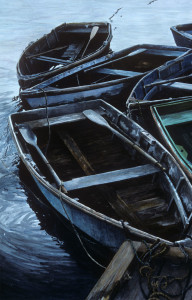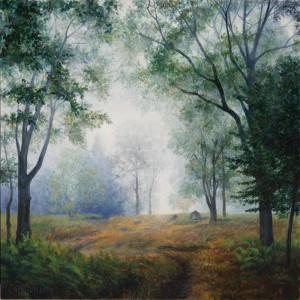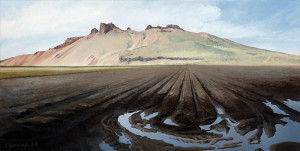
© Cathy Jennings 1997
Mark Golden: Cathy, how did you get started making art?
Cathy Jennings: I don’t remember a time when I wasn’t making images of what I see in the world and that seamlessly grew into drawing and painting.
Mark: Who were the mentors in your life that guided you in that way – parents, teachers?
Cathy: My parents were teachers and were always supportive and encouraged me. My Mom taught at a public school working with children who had learning disabilities and my Dad taught religion and ethics at a liberal arts college.
Mark: What a great combination! During school, did you continue to pursue arts?
Cathy: I did. I went to a public high school that had a very strong arts program. The main teacher was actually a neighbor, and I would go in before classes started and stay late. He was a very strong influence on me, but I knew before I went to high school that making paintings and drawings is what I wanted to do.
Mark: Were there other interests that you had in school, or was it always about creating art?
Cathy: I’ve always enjoyed learning and while in school, I was in the Gifted Program. History and literature, in particular, were other interests that I pursued and still do, to a great extent.
Mark: That makes a lot of sense – your writing is wonderful… so I imagined that there must have been other interests in school in addition to the arts as you were growing up. When you finished high school did you go onto college specifically to pursue an arts program?
Cathy: No, I considered going into an arts program, but I have a general love of learning and a broad interest in learning about a variety of things. Art schools tend to be a little more focused. I wanted to attend a liberal arts college where I could major in studio art, but still take history, literature, science, etcetera, as I wished.
I am also very much influenced by my surroundings. As I was looking at schools, I fell in love with the campus of Smith College, and that’s where I ended up going and majoring in Studio Art.
Mark: While there, was there any particular college faculty or mentors that greatly influenced you?
Cathy: Not one in particular. The overall atmosphere and supportive learning environment was a wonderful experience in every way.
Mark: What was your next step after college?
Cathy: I enrolled in the Graduate School of Fine Arts at the University of Pennsylvania because I knew I wanted to be a landscape painter. At that time, Neil Welliver was in charge of their painting program and he was a landscape painter. It was the mid-’80s, and at that time, representational painting was not necessarily being encouraged in some academic settings. Finding a program where I could pursue not just representational painting, but landscape painting, without fighting for it, was important to me. I studied oil painting and printmaking.
Mark: So was it at the graduate program that you finally felt confident enough to say, “I’m an artist”?
Cathy: I have a love-hate relationship with the word, “Artist.” I consider myself a painter primarily and maybe an artist second. And that was certainly true in graduate school.
Mark: Could you describe those differences – of how you divide that?
Cathy: There have been periods of time where materials, paint, paper, canvas, and the craft of making paintings or drawings, have been not so important. And painting as a created object has been not so important. It’s been more about words and concepts. When I was in grad school, it was a period when the verbal aspect of the visual arts was really popular.
People were spouting off all kinds of rather abstract, multi-syllabic explanations for what they were doing, and people still do that. Sometimes I have a very hard time making a connection between the verbiage that is the artist, the art world, the “art”, and the actual painting that is being presented for contemplation. When the verbiage is only loosely linked to the painting, the words can easily eclipse the object in importance. And for me, painting is at heart visual and any words should only support, not circumscribe. And so when I say I’m a painter, I’m sort of stepping back from all of that and reasserting my interest in the paint and in the processes and craft of painting.
Mark: I think that’s what makes you such a great support here for artists who are struggling just with the craft of making a painting.
We’re not in the exercise of having to create a verbal dialogue or battle about defending any one way of making a painting, other than the craft of making a painting and those things that stop people from being successful in that – the craft of doing their art. So, I think it’s a great connection to what we do and why you’re so good at doing what you do.
So, let’s switch gears a bit. Is there a way that you begin your work? Is it by taking photographs or is it about being out in nature, doing sketches? Tell me something about the creative process of how you get started.

© Cathy Jennings 2013
Cathy:I’ve been a landscape painter for decades and I developed a process where I create a series of works about a certain place. I go to that location and spend as much time in it as I can, and while I’m there, I create watercolors, draw, take notes and fill my sketchbook. I use a camera in a sense as a second sketchbook.
Everything I experience on location then comes back to the studio, and forms the environment in which I create studio work. It also speaks to my experience at that particular location. I think of it as subjective realism because my paintings tend to be highly representational, but filtered through me and my repeated experience of that particular location.
Mark: Do you have a special habit / ritual that you practice to get you ready for creating in your studio (grabbing a cup of tea, cranking up the music)?
Cathy: When I’m on location I don’t like to use earphones or music, anything that separates me from the location. Setting up the easel and the paints segues into the act of painting.
When I was painting up in Tule Lake in Northern California, I had meadow larks landing on my easel, antelopes coming and standing behind me while I was painting. In many ways, I feel like I’m connecting to the location when I’m painting and using earphones or playing music is a barrier to that. However, when I’m in the studio, I listen to music. Tea is one of my oldest rituals. Making a mug of tea and going to the studio helps me transition into the making process. Even if I don’t end up drinking the tea, simply the ritual of making it and carrying it, and having that warm container with me is part of my process.
Mark: So let me get back to your career. After graduate school, what was the next step in your development?
Cathy: After I earned my MFA, I was living in a cabin in the woods of Pennsylvania. I was teaching part-time and working as a designer for an embroidered emblem company. I was creating designs and patterns for embroidered jackets worn by firemen and Boy Scout jamboree badges. I was also painting and showing my work during this time.
And remember that artist vs. painter argument I’d been having? I decided that I really didn’t know enough about the theories behind all of the art speak that was happening. My MFA program was very firmly studio based. Therefore, I decided I wanted to go back to school. I didn’t want strict art history. I investigated a variety of options. I grew up in Pennsylvania, went to school in Massachusetts and Pennsylvania, so I wanted a chance to see the rest of the country.
I discovered a program at Texas Tech University which involved art history, a little bit of theater, a little bit of music, and philosophy – aesthetics, in particular. They accepted me, so I joined their doctoral program and graduated from there with a PhD in interdisciplinary fine arts.
Mark: That was a big change from where you were before, willing to challenge yourself to understand a little bit more about the aesthetics behind the craft?
Cathy: Yes, it was a big step. It also changed the environment in which I was living. I went from the wooded Northeast to flat, dusty, arid, surrounded by light all the time West Texas, which was hugely different.
Then I taught at California State University Chico, so I experienced Northern California, and I loved it. After I left there, I took a teaching job in eastern New Mexico, which was actually fairly close to Lubbock. The environment there was not suited for me.
Mark: What brought you to Golden Artist Colors in the center of upstate New York?
Cathy: I read the advertisement and I thought, “Oh, they wrote this for me!” It was an ideal position. It combined so many of my interests, so I applied. And now I’m here, and I have to say this is the best job I’ve ever had.
Mark: Can you describe a project that you’ve been involved in here that has been particularly interesting?
Cathy: The one closest to my heart has been QoR® Lightfastness testing. Ever since I started working with watercolor back in my MFA program, I’ve been very interested in the nature of the pigments that I’m using, and careful to have only lightfast paints on my palette. Aware of the ASTM lightfastness rating charts for watercolor, I’ve been very sad that they hadn’t been updated in so long. To be given the chance to actually be involved in that process is just tremendous!
Mark: When did you switch from oil paint to watercolor?
Cathy: When I was in grad school at Penn., Neil Welliver came into my studio one day and said, out of the blue, “I think you should try watercolor.” The next time I visited my parents, I went into a Dick Blick warehouse store, which was near them at the time, and started looking at watercolor paper. I fell in love with it. My love of watercolors came second. With watercolor paper and paints at hand, I started painting. I’m a self-taught watercolor painter to a great extent.
Mark: So, you’ve been working with watercolor for quite some time?
Cathy: Yes, since the mid-’80s and for about a decade and a half, it was my primary medium. More recently, I returned to oils and most recently, began painting with acrylics. Watercolor is a love of mine that’s always been there since graduate school.
Mark: So, with all the customer calls and emails you’ve handled related to questions about materials and process, what has been some of your most interesting interactions?

© Cathy Jennings 2004
Cathy: There have been some interesting conversations with painters who are concerned about how to properly prepare a support for oil painting or who are interested in the difference between granulating colors and non-granulating colors in watercolors.
It’s also been a real joy working with the artist residents staying at the Golden Foundation. A lot of them have not really spent time working with transparent watercolor. Introducing them to QoR and having them see how vivid and saturated the paint is, and how much clearer the individual personalities of the pigments can be with transparent watercolor vs. acrylics, for example, has been a lot of fun.
Mark: I know you’ve been on the phones answering questions from artists for just a short time, but I can attest to all the thank you letters that you’ve gotten. I’ve also seen the correspondence from artists who now have greater clarity based on the information you’ve been able to provide to them regarding their studio practice. Thanks so much for sharing your story.
To see more from Cathy visit her web page: cjenningsgallery.com.
About Golden Artist Colors, Inc.
View all posts by Golden Artist Colors, Inc. -->Subscribe
Subscribe to the newsletter today!
No related Post
